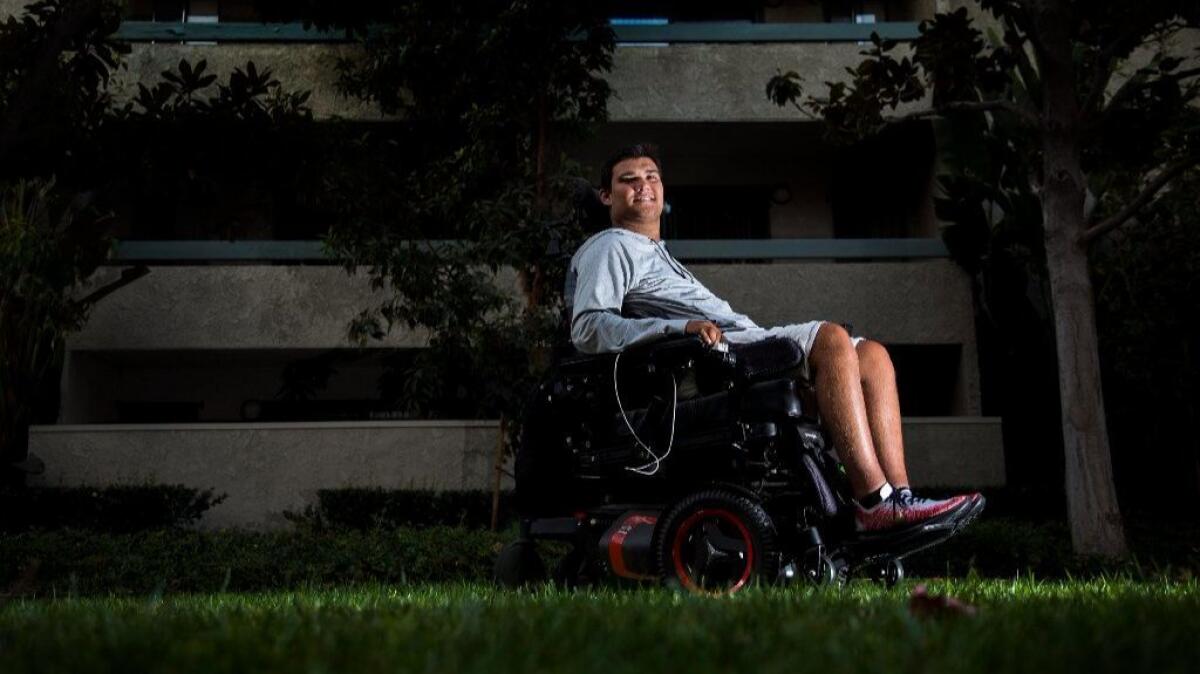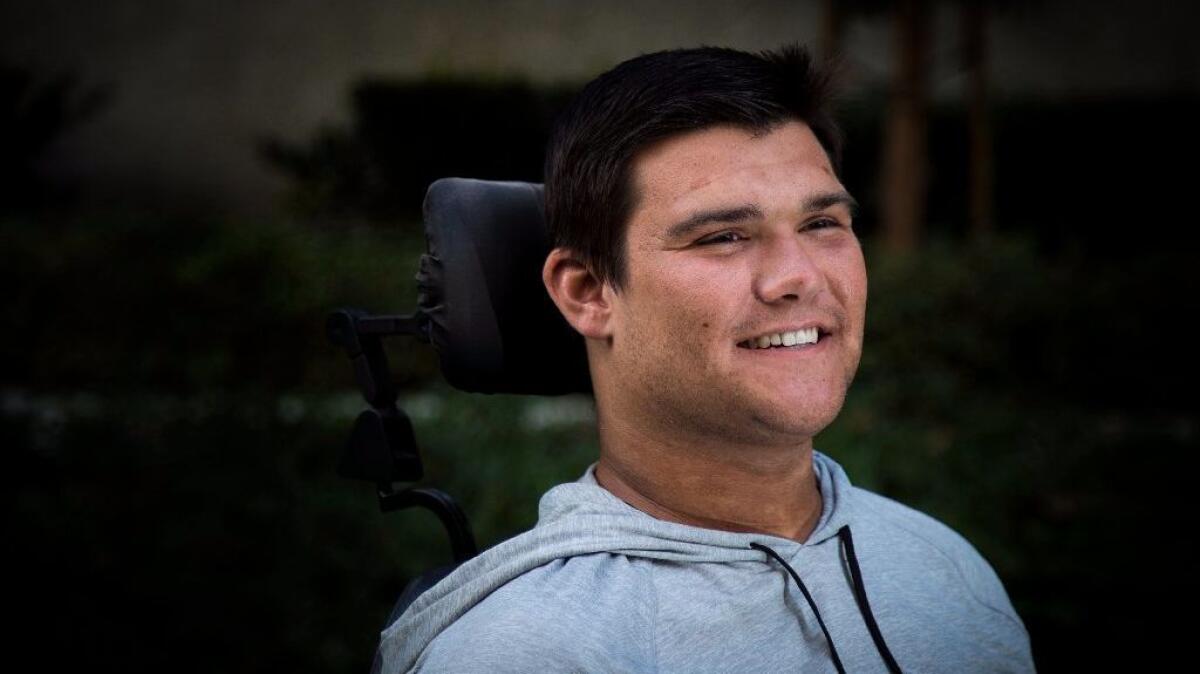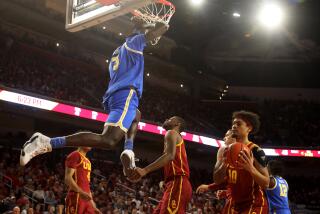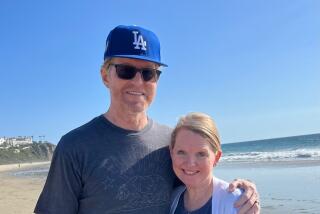Column: In pursuit of a miracle, paralyzed by a hockey injury, Jack Jablonski finds purpose, and sees movement, off the ice

Relying on his mind to prevail over limbs that had become paralyzed after he was driven face-first into the boards during a Minnesota high school hockey game nearly six years ago, Jack Jablonski stared at his feet one recent night and willed them to move.
He had come to believe in a connection between mind and body since his C5 and C6 vertebrae were broken and his spinal cord was severed by that unexpected hit, which he considers a hockey play but made with an elbow and stick that were too high. His doctors told him he’d probably never bend his right arm. Determined to prove them wrong, he bent it a week later.
Since the accident in his sophomore year, on Dec. 30, 2011, physical therapy has allowed him to activate some muscles in his core and lower back and regain some control of his biceps. He also got into the habit of focusing on his feet, especially when he wore flip-flops and could directly look at his feet and toes, but the mind-body link there remained elusive … until about 10 days ago, when he saw a twitch.
It was small, but it provided an enormous emotional boost. “Just got my right big toe to move a little bit!” he said via Twitter, adding the hashtag “#littlebylittle”.
As of a few days ago, he hadn’t repeated that movement. But the fact that he did it was worth celebrating and incentive for him to continue raising money for spinal cord injury research through his Bel13ve in Miracles Foundation, which partners with the Mayo Clinic. The 13 represents his jersey number at Benilde-St. Margaret’s High School and his admiration for skillful former Detroit star Pavel Datsyuk.
For now, that toe twitch is a small candle in a dark room, casting a brave, defiant light on his path toward regaining as much function and independence as he can.
“I know for a fact I did it on my own and it wasn’t just a spasm,” said Jablonski, who this week will complete his third year at USC as a communications major with a sports media minor and is in his third season as an intern with the Kings. “At the same time, I expect it to come and go. Whether it’s progress or not, the most important thing is something’s connected, and I was told from Day One it’s a complete sever.”
Back in Minneapolis his mother, Leslie, was getting texts from friends about his achievement. He doesn’t always tell her about things such as that for fear she might get too excited. Understandably, she was thrilled.
“It’s not supposed to be possible. His spinal cord, they said, was severed, and if it’s severed, you’re not supposed to move below the level of injury,” she said. “And for these things that he’s been able to do, I’m sorry, I have to think there’s something still left, even if it’s one thread. That’s all you need to get things possibly moving again.”
Jablonski, 22, isn’t merely waiting for miracles to materialize. He’s pursuing medical advances such as epidural stimulation, which has allowed some spinal cord injury patients to bear some of their own weight and make stepping-like motions, and he’s carving out a new life that’s still centered on hockey.
You learn to adjust. That’s just life with paralysis. ... The best way I can describe my injury is I understand my injury but I don’t accept it.
— Jack Jablonski

He has worked in public relations for the Kings and is featured on their “All the Kings Men” podcast, a natural progression from the radio show he hosted in high school and his summertime experiences shadowing various Minnesota Wild executives. It’s a great fit because he’s smart and gregarious. His upbeat attitude inspired his teammates to win the state championship after he was hurt. When friends visited him in the hospital and were uncomfortable, he’d lift their spirits.
“I knew how hard it would be for them and I always wanted to make them feel welcome and get the elephant in the room off their mind,” he said.
Kelly Cheeseman, the Kings’ chief operating officer, attended the same high school but earlier than Jablonski and didn’t know him. They connected when the school’s hockey coach, Ken Pauly, told Cheeseman that Jablonski was coming to USC. Cheeseman met him and gladly became a mentor.
“I’d like him to be able to do more when he has the time. He has a great hockey mind and I know that he’s impressed a lot of people,” Cheeseman said. “I know he did some particular scouting for our high school team after he got injured. They really valued his input.”
Jablonski lives in a handicap-accessible apartment a block from campus. His room is decorated with photos of him playing in an outdoor game in minus-20 degree temperature, of his high school jersey being retired, and of him with retired NHL star Jeremy Roenick, a friend and tireless fundraiser for Jablonski’s foundation. A full-time caretaker tends to Jablonski’s medical needs and whatever else comes up, such as the fire alarm that went off at 3:30 a.m. one day last week.
“That’s how it is. It’s college,” Jablonski said, smiling.
Friends, his Tau Kappa Epsilon fraternity brothers, and representatives of USC’s Disability Services Program help him with tasks such as notetaking, though he can type on his phone with his right thumb. His younger brother, Max, joined him at USC this year and pledged the same fraternity. “It’s great to have him around,” Jablonski said.
Jablonski is on a five-year plan, taking 12 credits per semester. “I’m in no rush. It’s literally paradise here, especially coming from Minnesota,” he said, noting that his disability leaves him unable to control his body temperatures and he’s often cold. Every day is a challenge: For a 10 a.m. class he must wake up at 7:30 to get ready and he must prepare for every possible emergency. He also has learned to avoid taking classes in buildings that are difficult to navigate.
“After three years you’ve kind of got it down to a system,” he said, “but at the same time, if one thing lets go, everything could just fall apart. You learn to adjust. That’s just life with paralysis. … The best way I can describe my injury is I understand my injury but I don’t accept it. I’m aware of what happened. I understand the obstacles I’m going to have to conquer. But I’m always going to keep striving.”
Maybe he’ll be an NHL team executive. Maybe a commentator. He bears no grudge toward the sport that was the backdrop for his accident.
“Your normal reaction would be, ‘I’m never going back into a rink again,’ but I know how much the game meant to him and how much he loved it,” his mother said. “To see him still be involved in a different way, using his mind and his voice, is just incredible. Hockey will always be a part of his life and our lives.”
The extent of his connection is eerie. “To this day, I still feel like I have skates on my feet. It’s very weird,” he said. “That’s the last feeling I had. Do I feel like I have breezers [hockey pants] and shin pads on? I don’t really know, but for some reason they still feel like they’re in skates.”
He believes he will walk again someday. No one who has met him can doubt that.
“To hear that he’s moved his big toe, it gives you hope,” Cheeseman said. “I know he’s worked very, very hard at it. He works his tail off every day to get better, and I think that also reflects on how hard he works to get better at what he wants to do in life next. That’s what we value in the organization, and I think he’ll have an imprint with us as long as he wants to be here.”
Follow Helene Elliott on Twitter @helenenothelen
More to Read
Go beyond the scoreboard
Get the latest on L.A.'s teams in the daily Sports Report newsletter.
You may occasionally receive promotional content from the Los Angeles Times.






